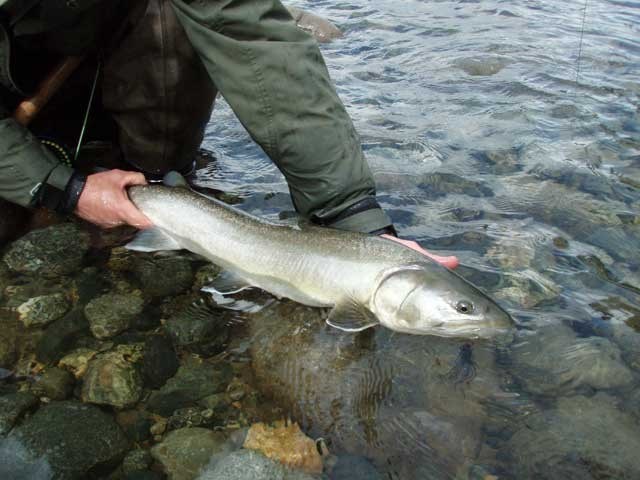Fall is now arriving in the Whistler valley and while most of
us are thinking about cooler temperatures and what to be for Halloween, Whistler’s
bull trout are heading upstream looking for a place to spawn.
Autumn’s colder water temperatures trigger annual spawning
behavior of the bull trout (
Salvelinus confluentus
) living in Green Lake. Bull trout spawn in cold and
steep tributary streams. Whistler’s bull trout spawn mainly in Fitzsimmons and
Blackcomb Creeks, but not much is known about the number of bull trout coming
up each stream.
For the past three years, the Ministry of Environment Fish and
Wildlife Section, in cooperation with the B.C. Conservation Foundation,
Whistler Fisheries Stewardship Group and Whistler Angling Club, has been
operating a fish fence and trap in Blackcomb Creek to monitor bull trout
spawning activity. The Ministry hopes to gain information on the number, timing,
size and distribution of bull trout in Blackcomb Creek. In 2006, the fish fence
was installed at the mouth of Blackcomb Creek from Sept. 11 to Oct. 10, where
it captured a mere 17 fish — they truly are rare. In 2007, this number
increased to 23 fish during the 30-day fish fence operation from Sept. 6 to
Oct. 6. For 2009, the Ministry of Environment is hoping to enhance the existing
program with bull trout radio tracking to learn more about spawning activity in
the main waters of Fitzsimmons Creek. Partnerships will be formed and an
application for funding will be made to the Habitat Conservation Trust
Foundation this November.
This year, the bull trout fence was installed upstream of its
former location, just below the confluence of Horstman Creek with Blackcomb
Creek, on Aug. 22. The fence, which will be in place until we are sure we have
monitored the spawning bull trout, is highly visible from the Blackcomb Creek
bridge along Cedar Way Trail. Be sure to look down over the edge as you ride or
walk by the bridge. If you’re lucky, you’ll see our technician, Brian, pulling
a big spawner from the trap. Please refrain from getting close to the fence at
anytime. Your presence could stress the trapped fish and high water flow can be
very dangerous to people. All the information you need to understand and
support our local bull trout is contained on a project-specific interpretative
sign on the bridge. A permanent bull trout interpretive sign will be installed
on the Fitzsimmons Creek covered bridge later this month.
This location, higher up the stream was chosen this year to
help determine the utmost reaches of bull trout spawning. The fence was also
installed two weeks earlier than in previous years, as many of the bull trout
were captured moving downstream, indicating that they moved up the system prior
to the trap being installed. We hope to capture the upstream spawning migration
during this year’s fence operation, so we can get a better count and zero in on
spawning migration timing of the fish.
“This year, since the fence went in, there has been no rain,”
says Vesna Young, RMOW Fish and Wildlife Technician. “As soon as it rains we
are expecting to see the first bull trout through the fence. This is really
exciting.”
In B.C., bull trout is a blue-listed (threatened) species,
meaning that they are a sensitive species vulnerable to human and natural
disturbances. The small tributary streams these species use for spawning and
rearing are extremely susceptible to human impacts such as sedimentation, loss
of streamside vegetation, and increases in water temperature.
As a resort community committed to enhancing and protecting
native biodiversity through action moving us toward our Whistler2020 vision,
anglers and nature lovers alike get satisfaction from seeing healthy populations
of fish in our lakes and streams. Whistler’s waterways support populations of
kokanee, rainbow trout, bull trout, sculpins, threespine stickleback, and, more
recently in Alta Lake, cutthroat trout. The increasingly rare bull trout is
indigenous to the Whistler area, as are sculpin and, likely, stickleback. These
fish are our true Whistler natives. Both rainbow trout and kokanee have
been stocked in Whistler area lakes since the early 1920s as part of a
nationwide (and continent-wide) effort to enhance angling opportunities
throughout the country. Remnants of these populations have become naturalized
in the area and reproduce in the wild, continuing on their existence in the
Whistler Valley. The Ministry of Environment also stocks sterile rainbow
and cutthroat trout in our lakes on an annual basis.
Whistler’s first resort development was created by Alex and
Myrtle Philip in 1911 as an angling destination on the shores of Alta Lake.
Through continued and diligent efforts to monitor, protect and enhance our
native fishery, we should all be able to enjoy bull trout and their piscine
friends for generations to come.
To learn more about Whistler’s on the ground actions to
support Whistler2020 go to Whistler2020.ca. Look for updates on the number and
size of bull trout from the fish trap project on the home page starting today.




